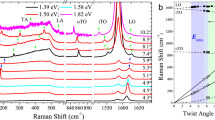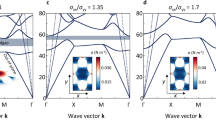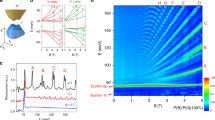Abstract
Fano resonances are features in absorption, scattering or transport spectra resulting from the interaction of discrete and continuum states. They have been observed in a variety of systems1,2,3,4,5,6. Here, we report a many-body Fano resonance in bilayer graphene that is continuously tunable by means of electrical gating. Discrete phonons and continuous exciton (electron–hole pair) transitions are coupled by electron–phonon interactions, yielding a new hybrid phonon–exciton excited state. It may also be possible to control the phonon–exciton coupling with an optical field. This tunable phonon–exciton system could allow novel applications such as phonon lasers.
This is a preview of subscription content, access via your institution
Access options
Subscribe to this journal
Receive 12 print issues and online access
$259.00 per year
only $21.58 per issue
Buy this article
- Purchase on Springer Link
- Instant access to full article PDF
Prices may be subject to local taxes which are calculated during checkout



Similar content being viewed by others
References
Fano, U. Effects of configuration interaction on intensities and phase shifts. Phys. Rev. 124, 1866–1878 (1961).
Fano, U. & Rau, A. R. P. Atomic Collisions and Spectra (Academic Press, 1986).
Adair, R. K., Bockelman, C. K. & Peterson, R. E. Experimental corroboration of the theory of neutron resonance scattering. Phys. Rev. 76, 308 (1949).
Cerdeira, F., Fjeldly, T. A. & Cardona, M. Effect of free carriers on zone-center vibrational modes in heavily doped p-type Si. 2. Optical modes. Phys. Rev. B 8, 4734–4745 (1973).
Faist, J., Capasso, F., Sirtori, C., West, K. W. & Pfeiffer, L. N. Controlling the sign of quantum interference by tunnelling from quantum wells. Nature 390, 589–591 (1997).
Gores, J. et al. Fano resonances in electronic transport through a single-electron transistor. Phys. Rev. B 62, 2188–2194 (2000).
Zhang, Y. B., Tan, Y. W., Stormer, H. L. & Kim, P. Experimental observation of the quantum Hall effect and Berry's phase in graphene. Nature 438, 201–204 (2005).
Novoselov, K. S. et al. Two-dimensional gas of massless Dirac fermions in graphene. Nature 438, 197–200 (2005).
Ferrari, A. C. et al. Raman spectrum of graphene and graphene layers. Phys. Rev. Lett. 97, 187401 (2006).
Yan, J., Zhang, Y. B., Kim, P. & Pinczuk, A. Electric field effect tuning of electron–phonon coupling in graphene. Phys. Rev. Lett. 98, 166802 (2007).
Pisana, S. et al. Breakdown of the adiabatic Born–Oppenheimer approximation in graphene. Nature Mater. 6, 198–201 (2007).
Yan, J., Henriksen, E. A., Kim, P. & Pinczuk, A. Observation of anomalous phonon softening in bilayer graphene. Phys. Rev. Lett. 101, 136804 (2008).
Wang, F. et al. Gate-variable optical transitions in graphene. Science 320, 206–209 (2008).
Mak, K. F. et al. Measurement of the optical conductivity of graphene. Phys. Rev. Lett. 101, 196405 (2008).
Li, Z. Q. et al. Dirac charge dynamics in graphene by infrared spectroscopy. Nature Phys. 4, 532–535 (2008).
Kuzmenko, A. B., van Heumen, E., Carbone, F. & van der Marel, D. Universal optical conductance of graphite. Phys. Rev. Lett. 100, 117401 (2008).
Zhang, Y. et al. Direct observation of a widely tunable bandgap in bilayer graphene. Nature 459, 820–823 (2009).
McCann, E. Asymmetry gap in the electronic band structure of bilayer graphene. Phys. Rev. B 74, 161403 (2006).
Ohta, T., Bostwick, A., Seyller, T., Horn, K. & Rotenberg, E. Controlling the electronic structure of bilayer graphene. Science 313, 951–954 (2006).
Castro, E. V. et al. Biased bilayer graphene: semiconductor with a gap tunable by the electric field effect. Phys. Rev. Lett. 99, 216802 (2007).
Guinea, F., Neto, A. H. C. & Peres, N. M. R. Electronic states and Landau levels in graphene stacks. Phys. Rev. B 73, 245426 (2006).
Lu, C. L., Chang, C. P., Huang, Y. C., Chen, R. B. & Lin, M. L. Influence of an electric field on the optical properties of few-layer graphene with AB stacking. Phys. Rev. B 73, 144427 (2006).
Oostinga, J. B., Heersche, H. B., Liu, X. L., Morpurgo, A. F. & Vandersypen, L. M. K. Gate-induced insulating state in bilayer graphene devices. Nature Mater. 7, 151–157 (2008).
Eklund, P. C. & Subbaswamy, K. R. Analysis of Breit–Wigner line-shapes in the Raman-spectra of graphite-intercalation compounds. Phys. Rev. B 20, 5157–5161 (1979).
Wang, Z. H., Dresselhaus, M. S., Dresselhaus, G. & Eklund, P. C. Raman studies of electron–phonon interaction in Kxc70. Phys. Rev. B 48, 16881–16884 (1993).
Rao, A. M., Eklund, P. C., Bandow, S., Thess, A. & Smalley, R. E. Evidence for charge transfer in doped carbon nanotube bundles from Raman scattering. Nature 388, 257–259 (1997).
Brown, S. D. M. et al. Origin of the Breit–Wigner–Fano lineshape of the tangential G-band feature of metallic carbon nanotubes. Phys. Rev. B 63, 155414 (2001).
Ando, T. & Koshino, M. Field effects on optical phonons in bilayer graphene. J. Phys. Soc. Jpn 78, 034709 (2009).
Malard, L. M., Elias, D. C., Alves, E. S. & Pimenta, M. A. Observation of distinct electron–phonon couplings in gated bilayer graphene. Phys. Rev. Lett. 101, 257401 (2008).
Lazzeri, M., Piscanec, S., Mauri, F., Ferrari, A. C. & Robertson, J. Phonon linewidths and electron–phonon coupling in graphite and nanotubes. Phys. Rev. B 73, 155426 (2006).
Das, A. et al. Phonon renormalization in doped bilayer graphene. Phys. Rev. B 79, 155417 (2009).
Wallentowitz, S., Vogel, W., Siemers, I. & Toschek, P. E. Vibrational amplification by stimulated emission of radiation. Phys. Rev. A 54, 943–946 (1996).
Liu, H. C. et al. Coupled electron–phonon modes in optically pumped resonant intersubband lasers. Phys. Rev. Lett. 90, 077402 (2003).
Bargatin, I. & Roukes, M. L. Nanomechanical analog of a laser: amplification of mechanical oscillations by stimulated Zeeman transitions. Phys. Rev. Lett. 91, 138302 (2003).
Kuzmenko, A. B. et al. Gate tunable infrared phonon anomalies in bilayer graphene. Phys. Rev. Lett. 103, 116804 (2009).
Acknowledgements
This work was supported by the University of California at Berkeley and the Office of Basic Energy Sciences, US Department of Energy under contract no. DE-AC03-76SF0098 (Materials Science Division) and contract no. DE-AC02-05CH11231 (Advanced Light Source). Y.Z. and F.W. acknowledge support from a Miller Fellowship and a Sloan Fellowship, respectively. T.T.T. is partially supported by the National Science Council, Taiwan.
Author information
Authors and Affiliations
Contributions
F.W. designed the experiment. T.T.T, Y.Z., B.G. and C.G. fabricated the sample. T.T.T., Y.Z., Z.H., M.C.M. and F.W. performed infrared spectroscopy measurements. C.H.P., S.G.L and F.W. carried out the calculations. T.T.T., Y.Z., C.H.P, A.Z., M.F.C., S.G.L, Y.R.S. and F.W. co-wrote the paper.
Corresponding author
Supplementary information
Supplementary information
Supplementary information (PDF 432 kb)
Rights and permissions
About this article
Cite this article
Tang, TT., Zhang, Y., Park, CH. et al. A tunable phonon–exciton Fano system in bilayer graphene. Nature Nanotech 5, 32–36 (2010). https://doi.org/10.1038/nnano.2009.334
Received:
Accepted:
Published:
Issue Date:
DOI: https://doi.org/10.1038/nnano.2009.334
This article is cited by
-
High Q Factor and Sensitivity Fano Resonance Based on a Graphene-With Ring-Column Dimer Array Structure
Plasmonics (2024)
-
Quantum interference between dark-excitons and zone-edged acoustic phonons in few-layer WS2
Nature Communications (2023)
-
Tracking photocarrier-enhanced electron-phonon coupling in nonequilibrium
npj Quantum Materials (2022)
-
Human-muscle-inspired single fibre actuator with reversible percolation
Nature Nanotechnology (2022)
-
Broadband infrared study of pressure-tunable Fano resonance and metallization transition in 2H-\(\hbox {MoTe}_2\)
Scientific Reports (2022)



